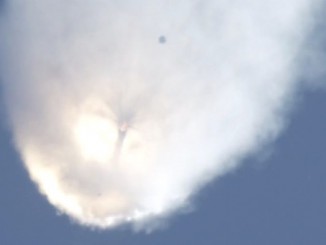
SpaceX’s launch team in Cape Canaveral fueled a Falcon 9 rocket with super-chilled liquid propellants and briefly fired the first stage’s nine Merlin engines Monday in a customary preflight test ahead of Wednesday’s scheduled liftoff of a commercial television broadcasting satellite for the Asia-Pacific.
Ground crews rolled the 229-foot-tall Falcon 9 rocket out of its hangar at Cape Canaveral’s Complex 40 launch pad and raised it vertical early Monday, then ran the launcher through a series of tests before pumping super-cold liquid oxygen and RP-1 — a refined grade of kerosene — into the two-stage vehicle.
The rocket entered a computer-controlled terminal countdown sequence, prepared its nine first stage Merlin 1D engines for ignition, switched to internal power, and pressurized its propellant tanks in the final minutes of the countdown test.
The first stage engines lit for several seconds as the countdown clock reached zero, throttling up to full power to collectively generate 1.3 million pounds of thrust. Moments later, computers commanded the engines to shut down and safed the rocket as engineers prepared to drain propellants from the Falcon 9.
SpaceX confirmed the successful completion of the “static fire” test in a tweet Monday afternoon, adding that the rocket is still targeting liftoff Wednesday.
Monday’s static fire test occurred with the SES 9 communications satellite mated to the top of the Falcon 9.
Weighing approximately 11,700 pounds (5,300 kilograms), SES 9 is destined to broadcast television programming over the Asia-Pacific and connect crews and passengers aboard ships traversing the Indian Ocean with coworkers, families and friends.
Built by Boeing and owned by SES of Luxembourg, the spacecraft will be operational in mid-2016.
The launch window Wednesday opens at 6:46:14 p.m. EST (2346:14 GMT) and extends until 8:23 p.m. EST (0123 GMT).
The Falcon 9 rocket will aim to deploy SES 9 in an egg-shaped geostationary transfer orbit about 31 minutes after liftoff, according to SpaceX.
The flight will mark the 22nd Falcon 9 mission since its debut in June 2010, and the second launch of an upgraded version of SpaceX’s workhorse rocket outfitted to carry more fuel, generate additional thrust and haul heavier satellites into orbit.
It will also be the second Falcon 9 flight of the year, and the first SpaceX launch from Cape Canaveral in 2016.

Keeping with the company’s push toward turning the Falcon 9 into a partially reusable rocket, SpaceX will try to recover the rocket’s first stage booster on a barge in the Atlantic Ocean about 400 miles (650 kilometers) east of Cape Canaveral.
SpaceX achieved its first successful Falcon 9 rocket landing in December at Cape Canaveral, but the space transport firm is 0-for-3 when attempting experimental landings on an offshore platform.
For missions with heavier satellites bound for higher orbits — like SES 9 — the rocket is going too fast to turn around and return to Cape Canaveral, requiring a descent toward a landing ship in the ocean.
SpaceX officials caution the chance of a successful landing is even lower than normal, thanks to a late change in the launch profile for the SES 9 mission.
SES and SpaceX announced earlier this month an agreement for the Falcon 9 rocket to place the SES 9 satellite into a higher orbit than initially planned, reducing the time needed for the spacecraft to maneuver itself into its operational position in a circular geostationary orbit nearly 22,300 miles (36,000 kilometers) over the equator.
The adjustment allows SES 9 to enter service by the end of September, making up for a half-year of delays caused by a Falcon 9 launch failure last year.
The extra boost required to put SES 9 into a higher orbit translates into higher speeds for the first stage booster during its descent back to Earth, putting more stress on the rocket during re-entry.
U.S. Air Force meteorologists forecast brisk winds and cloudy skies Wednesday evening, with a 60 percent chance conditions will be acceptable for liftoff.
A low pressure system forming along the Gulf Coast will move east over the next day, bringing inclement weather to Florida’s Space Coast.
“On launch day, the low pressure system pulls northeast, dragging behind a cold front that will slowly make its way across Central Florida,” the Air Force weather team wrote in the official launch forecast. “There is a slight risk of strong thunderstorms during the afternoon as winds will remain quite gusty even outside of convection.
“The front should push through the spaceport during the launch countdown, but clouds may linger through midnight,” the forecast said. “The main weather threats for launch are strong winds and clouds during the launch window.”
The outlook issued Monday by the Air Force’s 45th Weather Squadron predicts scattered clouds 2,500 feet, 10,000 feet and 25,000 feet at launch time Wednesday. Isolated showers may be in the vicinity of Cape Canaveral.
Winds will be from the west at 17 to 22 mph, and the temperature at launch time should be around 69 degrees Fahrenheit.
If the Falcon 9 does not take off Wednesday, clearer skies Thursday will raise the probability of favorable weather to 80 percent, the Air Force said, with the chief concern then expected to be ground winds.
Email the author.
Follow Stephen Clark on Twitter: @StephenClark1.



